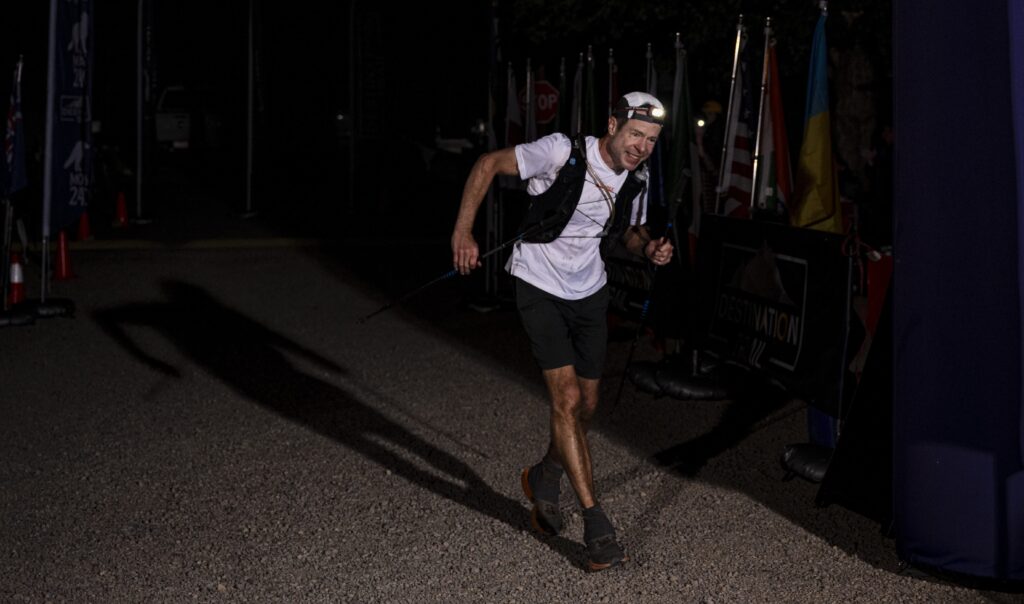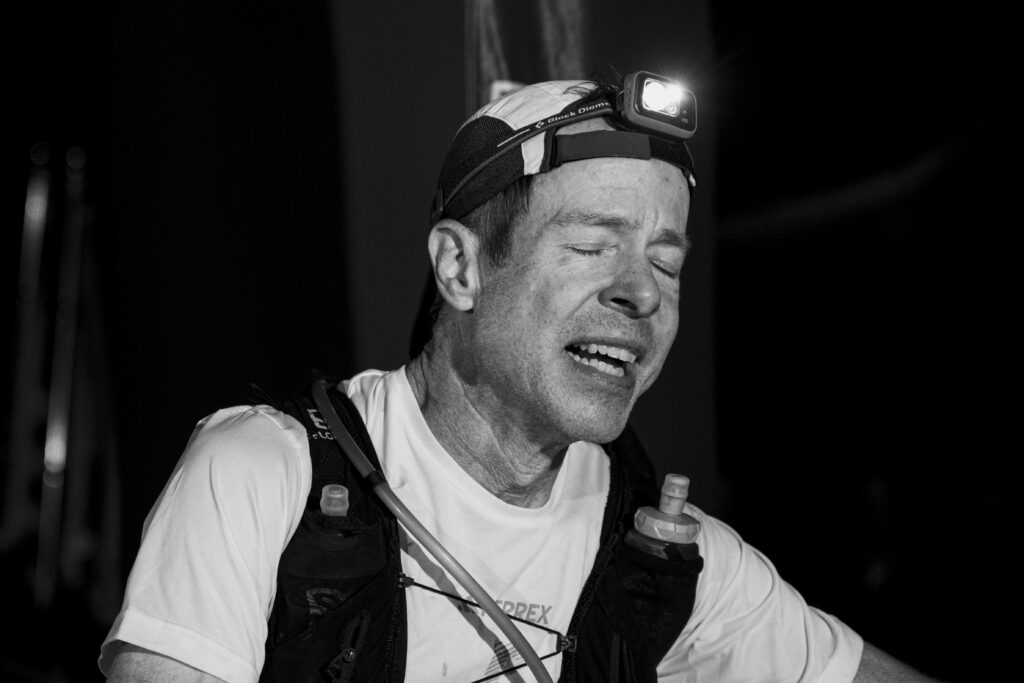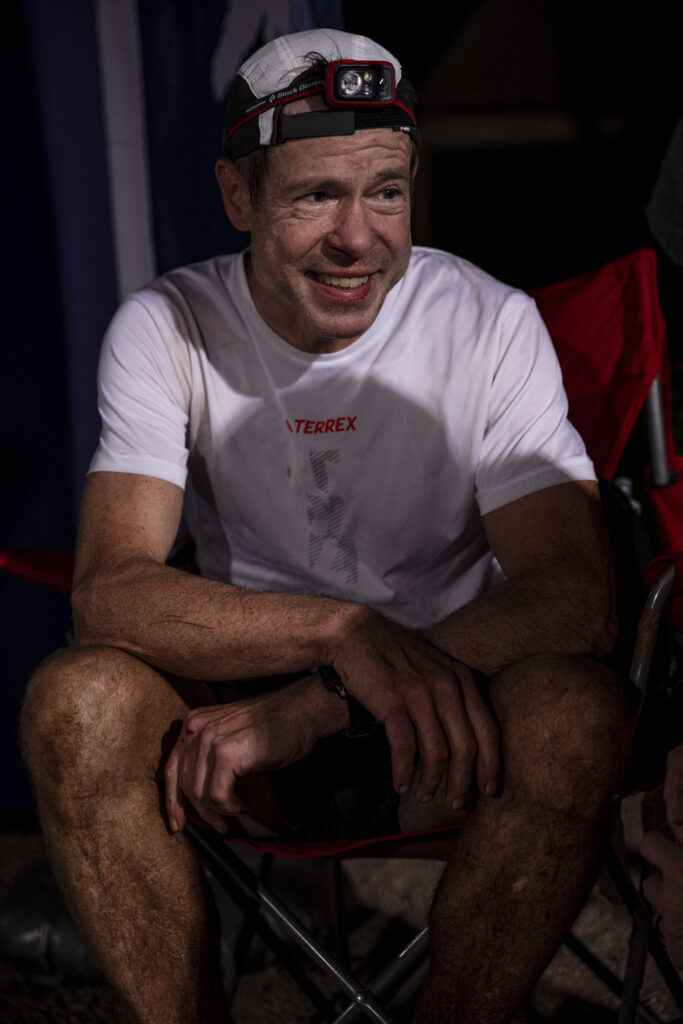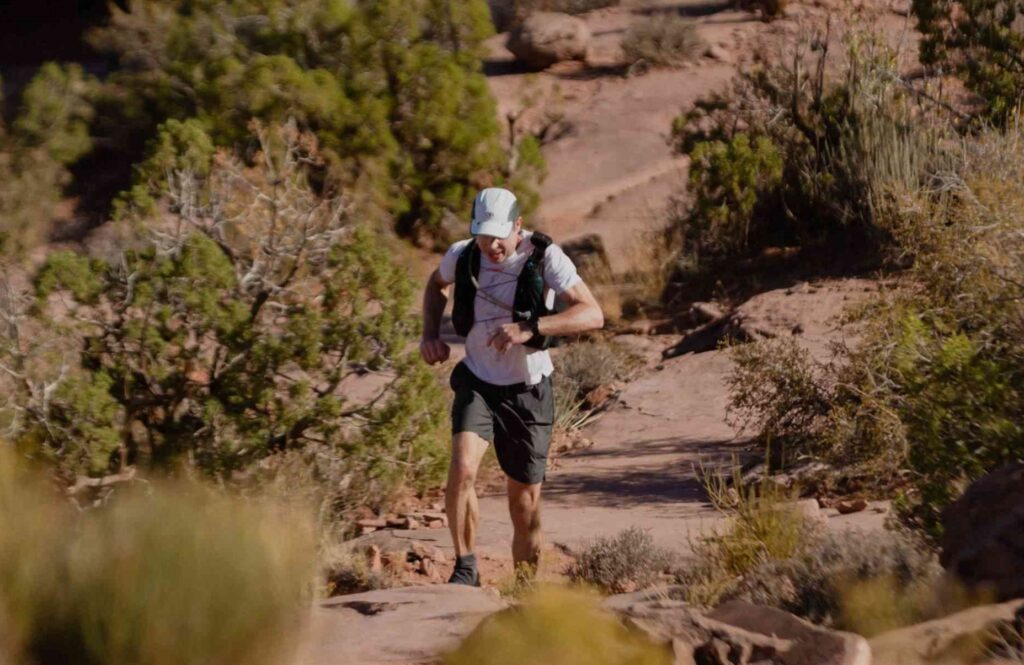
Moab to Base Camp (miles 0 to 29)
At noon on Friday, October 13, 2023, I stood at the starting line of the Moab 240 with a couple rows of runners ahead of me, and a larger group behind me. The midday desert sun felt warm, but today and the next few days would be notable for the relatively mild temperatures we would experience. Everyone seemed eager for the race to begin. 240 miles was a long distance to travel on foot, and we all wanted to start making progress in this adventure.
Although I was competing with all 201 of the other runners who toed the starting line that day, there was a subset of those 201 people who were competing in both the Moab 240 as an individual race, and also as part of a three-race series known as the Triple Crown of 200s. For me and 41 other runners in that subset, this was the final race of the series. About half of the Triple Crowners had already been dropped from the series because they had been unable to finish one of the two previous 200-mile races. Regardless, they stood with the rest of us, undaunted and ready to find success at Moab.
Going into Moab, I had a 9 ½ hour lead over the 2nd place Triple Crown runner, and a 16-hour lead over the 3rd place runner. While that was a huge buffer which would allow for numerous problems or mistakes, I was not going to take victory in the Triple Crown for granted. Anything could happen in a race as long as this one.
My body felt strong, and I was confident I had recovered from the grinding attrition of running the Tahoe 200 and the Bigfoot 200 a mere eighteen days apart. Like the other Triple Crown runners, I’d had eight weeks since Bigfoot to recover, rebuild and train. Eight weeks was enough. It had to be enough because it was all I had.
I slept well the night before the race. This was unusual for me at 200-milers, so I suspect it had something to do with the fact that the race was starting at noon for the first time in its seven-year history, instead of the usual 7 AM start. The change was made to reduce the amount of daylight hours spent by runners in the Lockhart Basin on the first day of the race. Lockhart Basin was a 40-mile long valley that could get miserably hot in the midday sun, and that heat had been a significant contributor to the high number of first-day DNFs (Did Not Finish) at Moab each year. Whether the change in start time had the desired impact is debatable. This year had the highest DNF rate of any year the race had been held. The average DNF rate for Moab was 26%, and the worst year prior to 2023 had been 34%. This year’s DNF rate was 45%.
When the starting horn was blown and we began running along the paved road through the town of Moab, I moved through the small pack of runners ahead of me within the first couple miles. By the time I hit the singletrack trail at the start of mile 4, I had moved into 4th place. I had started the race just a little more aggressively than I typically had. I wasn’t pushing myself hard. Instead, I was just trying to keep myself on the higher end of easy.
A few miles later I was suddenly in 1st place when I blew through the first aid station without stopping. The three runners ahead of me had all stopped to top-off their fluids. While I found my early lead to be surprising, I also knew it was meaningless. It’s easy to be in the lead in the early miles of a 200-miler. All you have to do is burn yourself out by running as if you were doing a much shorter race. Of course, you pay the price when your legs blow up thirty miles or a hundred miles later while all of your competitors pass you because they paced themselves well. In this case, I was confident I wasn’t running too fast. My shift into the lead was merely the result of a race plan which included carrying enough fluid from the start to get me through the first two sections of the course without stopping.
Jesse Haynes and Taylor Morris caught up to me in short order after the ascent to the top of the mesa overlooking Moab. We ran in the same vicinity of each other off and on for the next 13 miles until after the descent of the rocky tumble known as Jackson’s Ladder. At that point, they sped up a bit and left me in third place a short distance behind them. We were only 23 miles into the race and I felt no need to chase anyone. I focused on maintaining a steady effort through the long, sunny Lockhart Basin traverse. It was a relatively flat area of easy running, aside from places where the loose, sandy footing added a bit of friction to each stride.
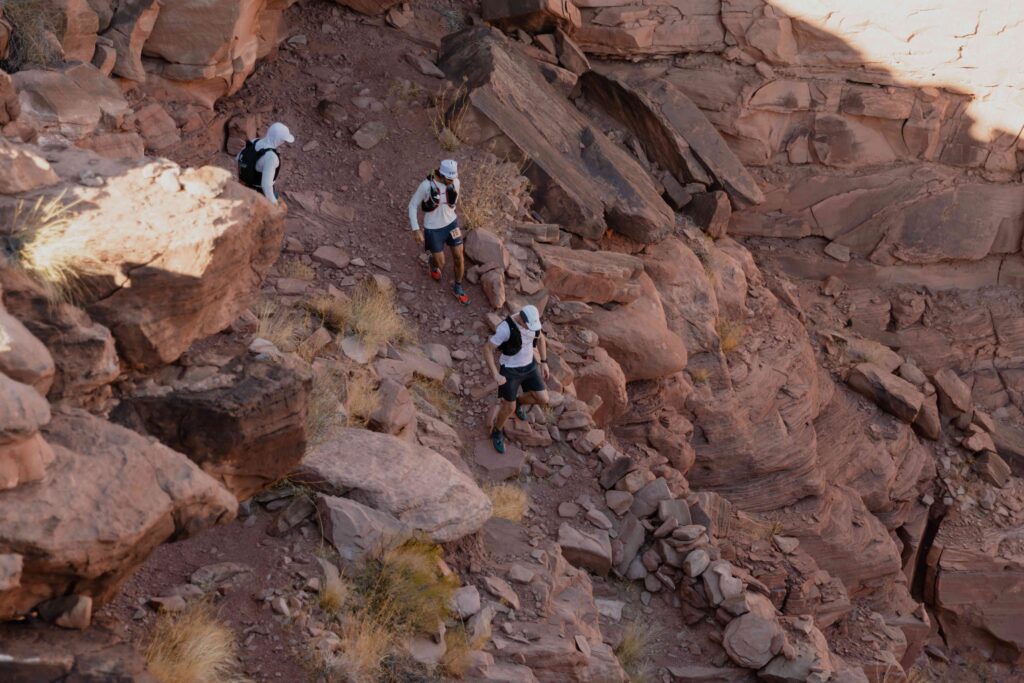
Base Camp to Indian Creek (miles 29 to 68)
Base Camp aid station was a quick stop for me. I filled up my bottles and then got back out on the trail. I enjoyed the fact that the later race start meant the temperatures would be dropping not long after I left the aid station. Aaron Kubala, a 28-year-old running his first 200-miler passed me on the way to The Oasis. He was in good spirits and was looking strong as we briefly ran together. He ran a solid race all the way back to Moab, eventually finishing 3rd place overall.
Ever since the Amasa Back aid station at mile 16, I’d been carrying a small pouch of mashed potatoes in my pack, primarily to provide a savory option for cleansing my palate of the sweetness from the electrolyte drink that was sustaining me. I never actually needed the potatoes for their palate cleansing properties, but I tapped into them around 9:30 PM, my first food of the race. I’d finished the last of my electrolyte drink a bit short of The Oasis so I ate several bites of potatoes to keep the calories flowing.
It was around that same time that my hydration pack decided it didn’t want to participate in the remainder of the event. The seam of one of the front bottle pouches split open, which meant I could no longer carry two bottles in the front of my hydration pack. It was nothing more than a minor irritation that required me to perform more bottle swaps between the front and rear of my pack, but it did remind me of the value of always having redundancy in the gear I bring to a race. In her truck, Heather was carrying a spare pack, spare trekking poles, spare gaiters, and spare everything else one can imagine. I would swap to a new pack when I saw Heather at Indian Creek.
The Oasis was another quick stop. I replenished the fluids in my bottles and bladder, drank some Coke, and was on my way. Chris Marcinek, a 35-year old veteran of the Moab 240, would arrive at Oasis shortly after me, and we’d end up trading places a couple times in the remaining miles of the race. This year he would have his second strong finish, taking 7th place overall as a great follow-up to a 5th place finish in 2019.
The 14 miles from Oasis to Indian Creek went by quickly. My caloric intake had been spot-on so far, I had kept the electrolytes in balance with my fluids, and the start time change meant I wasn’t as beaten down by the heat as I have been in some of my previous years running the race.
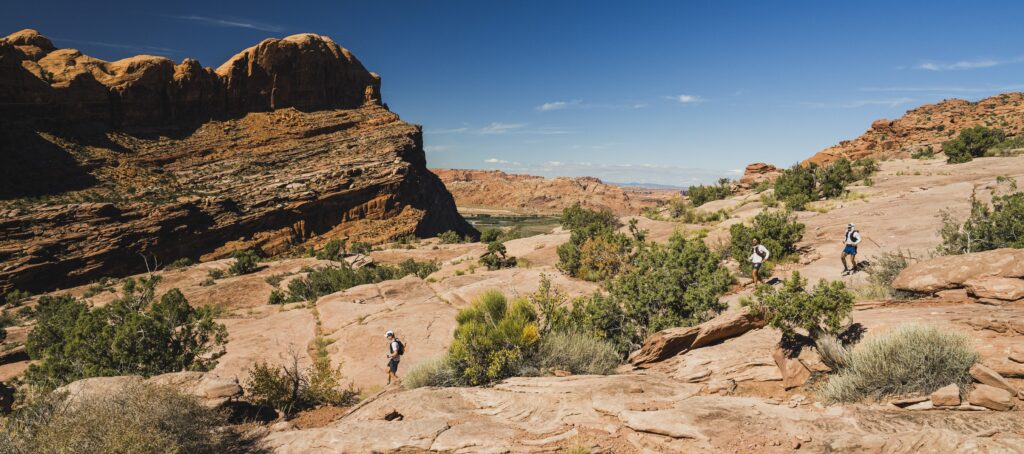
Indian Creek to Shay Mountain (miles 68 to 114)
Heather switched me to my backup hydration pack at Indian Creek, and the pack with the torn seam was set aside. I spent extra time at the aid station eating a few bites of potato soup and drinking additional fluids while Heather swapped my gear and race bib to the new pack. Clocking in at 30 minutes, the stop was my longest so far.
I maintained an easy jogging pace throughout the road portion of the route from Indian Creek to The Island. I didn’t move quite as well once I turned onto the trail portion. Although I never got off course, I did pull out my phone a few times to verify I was on the correct path. This was occurring around 3 AM, so it’s likely my mind wasn’t as sharp or as confident as it might normally have been, which in turn caused me to slow down.
At The Island a volunteer said I wasn’t far behind the leaders, which was nice encouragement. I was still hanging on to 4th place, but not by much. I’d seen the headlamps of other runners trailing close behind me. I replenished the fluids in my pack and then got back on the trail in about ten minutes. I ended up doing well with my aid station stops as a whole throughout the first 100 miles of the race, with six of the first seven aid station stops clocking in at ten minutes or less. Part of this gain in efficiency was a byproduct of the change I’d made to my fueling strategy in 2023. I’d shifted to a fluid-heavy diet. Although the change wasn’t specifically intended to improve aid station times, it inherently improved my efficiency because my stops consisted solely of pouring electrolyte into my bladder, then filling my bottles and bladder with water. There was no time spent grazing from the aid station food selection or asking for something to be made for me.
The section from The Island to Bridger Jack included multiple stops to check the progression of the solar eclipse which was occurring that day. The Destination Trail team had provided eclipse-viewing sunglasses in our swag bags at race check-in. It was a nice touch. Aside from my stops to view the eclipse, the section was uneventful. I moved at a pace that was quite a bit quicker than I had planned, an indicator that I was feeling strong and my body was getting what it needed.
Chris Marcinek and Anthony Shall were a short distance ahead of me during the descent out of the Bridger Jack area, and they stayed ahead of me through the dry wash at the bottom. This meant I had fallen back to 6th place. Although I passed both of them during the ascent up Shay Mountain, it was a short-lived lead. That climb is always a tough one, particularly the steep section before the crest of the ridge. As with most big climbs, I just kept hammering through it without stopping. Chris Marcinek passed me after the ascent when I stopped to take care of some biological business. Anthony would follow about ten minutes behind me for the next five miles as we made our way to Shay Mountain aid station.
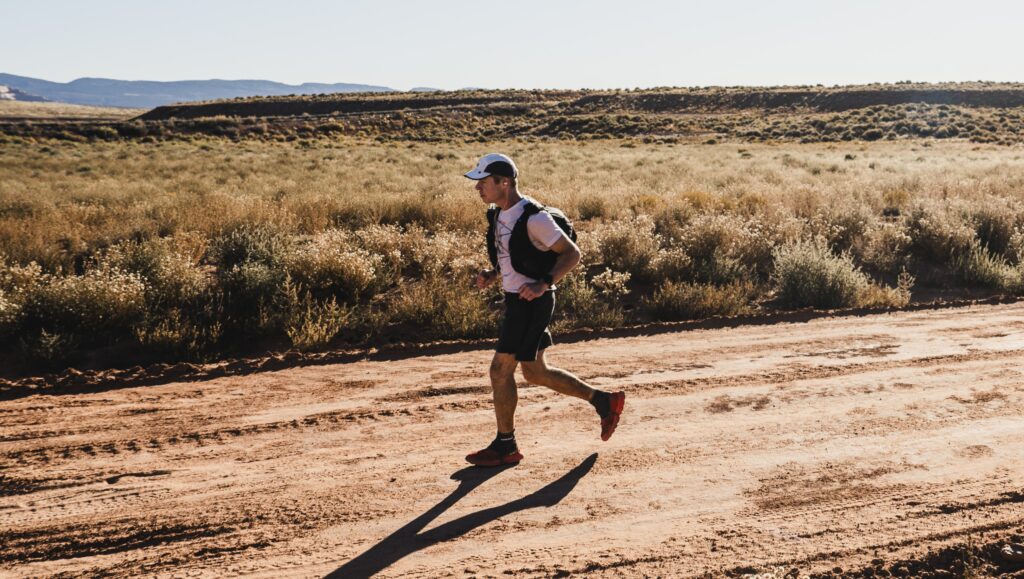
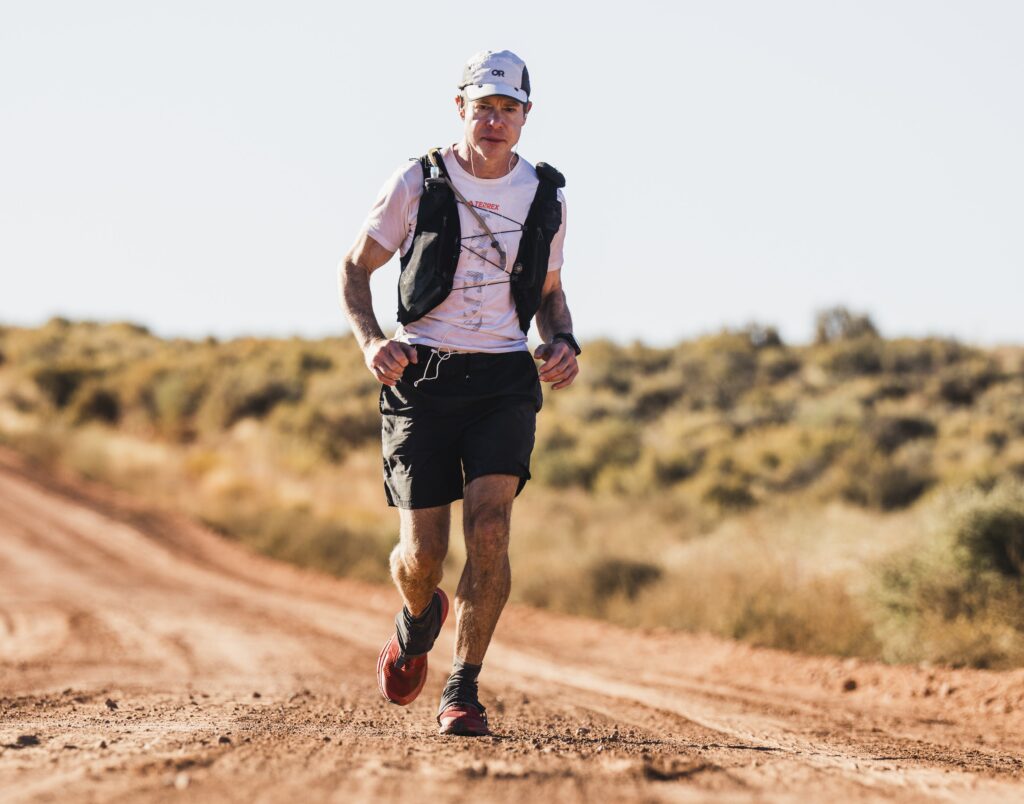
Shay Mountain to Road 46 (miles 114 to 171)
I dropped the ball a bit at Shay Mountain, and spent an extra thirty minutes getting refueled. Anthony arrived and departed the aid station during that time, grabbing a lead on me. Night fell during my ascent out of the Shay Mountain area. I ran as much as I could, but with almost 120 miles on my legs, my ability to run uphill had been impacted. When I hit the top of the ridge, I relished the thought of the remaining five miles being almost entirely downhill. But it was not to be. I started feeling sleepy and my legs were moving sluggishly. As a result, I was unable to take advantage of the downhill like I should have.
Despite the slow descent, I was still 45 minutes ahead of my planned arrival time when I hit Monticello Lake aid station, mile 126. At the time I was unaware of that fact. And that was exactly the way I wanted it. I never track myself against planned splits when I’m running a race. The primary purpose for planning my splits in advance of the race is to calculate the volume of calories, sodium and fluids I am likely to need during a section. It also gives Heather a rough idea of how long each of the sections will take me. It is not for holding myself accountable during the race. I pace myself based upon how I feel, not based upon what my watch says or what was written on a chart several weeks earlier.
Monticello Lake was an efficient stop. Heather got me through the station in 16 minutes, which is quite an accomplishment when I’m sleepy. Looking back on the race, it might have been wiser for me to use Monticello Lake as a sleep station rather than waiting for the next aid station at Dry Valley. I would have been more alert for the 17-mile journey to Dry Valley, and it might have helped to delay the lower back issues which, unbeknownst to me, were about to start.
It wasn’t many miles after I departed Monticello Lake that I felt the first sign of real trouble. The lower back muscles on my right side were starting to tighten in a manner beyond the normal cycle of muscle tightening and loosening that can occur during a long race. I’d only experienced this once before. It had happened during Moab 240 the previous year, and it didn’t go well. Last year it started at some point around mile 200, and it quickly progressed from tightness on one side of my lower back, to both sides of my lower back, and then to my abdominal muscles. At that point it became full-on runner’s lean, and both my posture and my range of movement became severely impaired.
Right now, I was barely at mile 130. This meant it was hitting me 70 miles earlier than last year. I was afraid this was going to get ugly. I hoped for the best, but I prepared myself mentally for the likelihood that I was soon going to have runner’s lean.
Dry Valley was a planned 90-minute sleep stop for me. By the time I arrived at the aid station, the right-side lower back pain had gotten worse, but it hadn’t spread to any other muscles. I knew that sleep helped relieve runner’s lean, even if it was only a temporary reprieve. That gave me some hope that maybe I could head this thing off before it fully manifested. I ate some food at the aid station before crawling into the pop-up tent on Heather’s truck. I turned on the white noise machine and passed out.
I had planned to use the 27 easy, dirt-road miles between Dry Valley and Road 46 to push my pace. However, with the increasing tightness in my back, my efforts were unsuccessful. I was not yet in a full-on runner’s lean, but my movement was noticeably impeded. Like a car speeding into a mud bog, my pace slowed from one section to next. I had been 45 minutes ahead of schedule when I arrived at Monticello Lake. When I reached Dry Valley, I was 2 ½ hours behind schedule, and by the time I arrived at Road 46 I’d fallen 5 ½ hours behind. Although I didn’t know these precise figures when I was running the race, I knew that I was getting progressively slower as my muscles continued tightening.
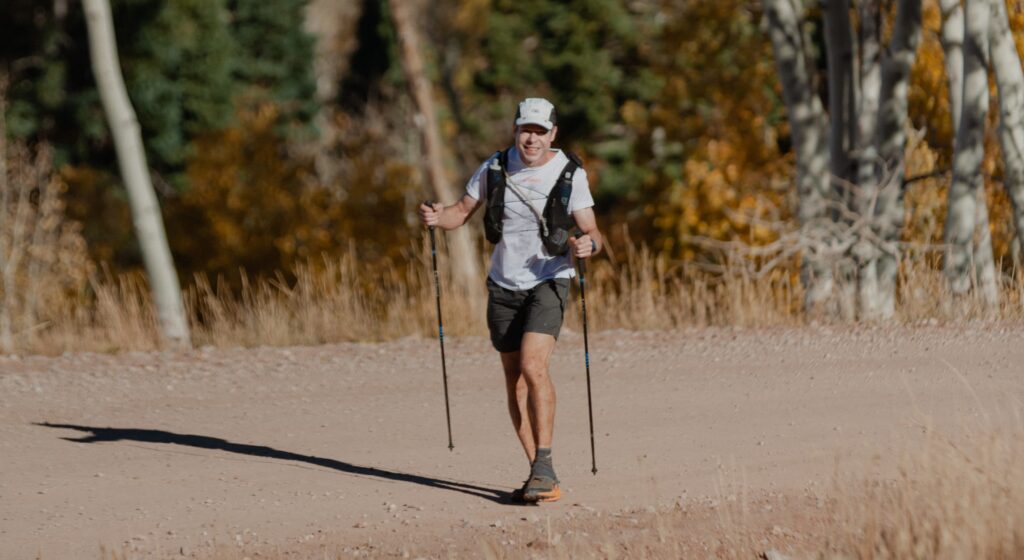
Road 46 to Geyser Pass (miles 171 to 200)
At Road 46 I took the time to use a borrowed foam roller on my back, and to lay on a cot and close my eyes for a few minutes while Heather took care of my hydration pack. It was 2 PM on Sunday and I was 171 miles into the race. The race had started fifty hours ago. My back was not doing well.
If the 27 miles leading up to Road 46 had been slow, the remaining 70 miles to the finish were downright lethargic. Runner’s lean had completely taken over my body, and my posture was that of a hunched old man. I tried to fight this by applying a lot of pressure onto my left trekking pole throughout all of those remaining miles, but even then, my posture was hunched forward and bent to the left. As a measure of how slowly I was moving relative to what I had done in the past, my pace in three of the four remaining sections of the course were the slowest of all seven times I had run the race.
At Pole Canyon aid station I refilled my bladder and bottles, and a volunteer was kind enough to try to loosen my back muscles with a massage gun he had brought. Although the gun seemed to relax my back a little, the effect wore off after the first mile or so.
After Pole Canyon, I climbed up the Doe Canyon trail, which was a new section of trail this year. I ended up missing a turn in the trail around the spot where Doe Canyon and Pole Canyon Trails intersect. Unaware I had missed a turn, I found myself in a narrow, overgrown ravine with an abundance of downed trees to climb over. My GPS signal was inaccurate due to the close, high walls of the ravine. The GPS app on my phone would show that the trail was to my left now, and then to the right five minutes later, and then two minutes after that it would seem to indicate the trail went right up the ravine that I had just been in. I must have spent twenty or thirty minutes trying to find my way back onto the actual trail.
It took me more than five hours to get to a stream a mere 7 miles from Pole Canyon aid station. Part of those five hours were due to getting lost in the ravine, but the majority of that time was spent hiking very slowly.
A sharp pain had developed in one specific muscle of my back to the right of my spine, likely a result of the muscles in the right side of my body attempting to compensate for the leftward lean. Otherwise, my back and abdominals were very uncomfortable, and their movement was severely restricted, but they were never painful in the way that the one particular muscle in my back was. And that pain was essentially the same regardless of whether I walked or ran.
The problem with my forced posture and the restricted range of torso movement was that it required an excess of energy to do my best version of a hunched-over run. Running became inherently unsustainable for any longer than a thirty to ninety-second burst. Within those ninety seconds my heart rate would go from a steady zone 1 or zone 2, to an above-the-aerobic-threshold zone 3 or even zone 4. When it became too much, I would slow down to a walk, and sometimes I would even stop to lean on my poles and rest for a few seconds. I was conscious throughout these remaining miles of how slow I was moving, but I refused to dwell on those thoughts. Instead, I focused on doing everything I could to stay moving and to keep repeating my short, high-intensity bursts when the terrain allowed it.
Mental strength is always a major component of any race as long as a 100-miler or a 200-miler. For me, it was no longer a major component, it was the only component. My physical limits were being dictated by the lean, and there was no way to fight what was physically happening to me. My battle had become very simple but immensely challenging. For the remaining 68 miles of the race, I would have to re-fight the same battle every couple minutes when I was moving across runnable terrain. I would have to force my body to do its crazy, twisted, bent, exhausting version of a run. Then I would walk to catch my breath and get my heart rate down. And then I would have to fight the same battle in my mind to get my body to run for another twenty or thirty or sixty seconds.
It was mentally and physically exhausting. I am not ordinarily one for using mantras, but I found myself saying positive words and phrases in my mind, and sometimes saying them aloud. I would mutter the words under my huffing breath as I struggled to sustain an awkward run for another few seconds.
The last few miles to Geyser Pass aid station were through a burn scar of shrubs and trees. These were miserable miles for me. The terrain was virtually all runnable, but even on the downhill sections my pace was ridiculously slow. In all, it took me ten hours to travel the 15 miles From Pole Canyon to Geyser Pass.
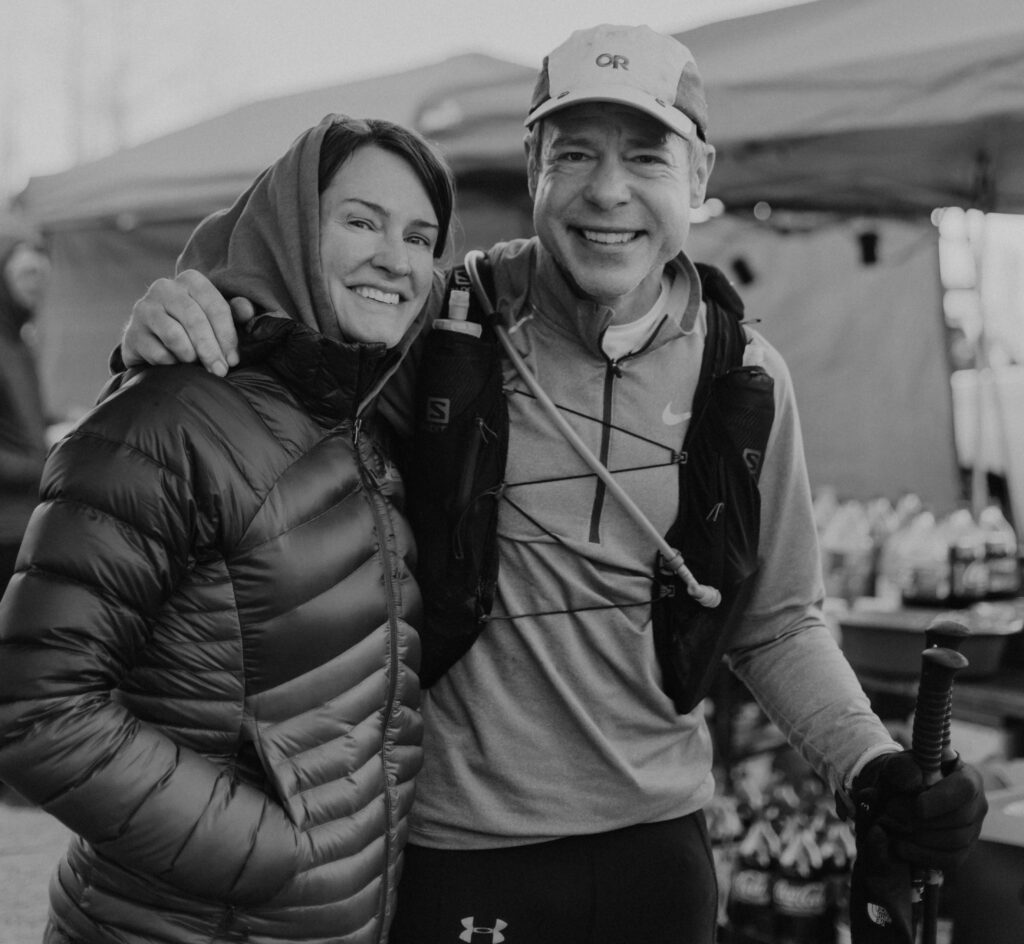
Geyser Pass to Porcupine Rim (miles 200 to 221)
I arrived at Geyser Pass at 6 AM, and, based on how slowly I’d been moving, I knew I needed to sleep again in order to keep up my strength and mental clarity. The sun wasn’t up yet, and with only 40 miles to the finish it wouldn’t make sense to try to sleep later unless I was just going to take dirt naps along the trail. Heather retrieved some food from the aid station volunteers while I sat in the warm cab of her truck. As always, I made a point of eating before laying down so the food could digest while I slept. Afterward, I hobbled over to the sleep tent, set my alarm for ninety minutes, and then closed my eyes. Sleep enveloped me within seconds.
When I finally got moving again, it was 9 AM. With every step up the dirt road ascent out of Geyser Pass I thrust my left trekking pole hard against the ground in an effort to prop my body into a slightly more upright posture. I’d been doing that for many miles, and it was creating a long blister on my left palm. Wearing a glove helped, but not enough.
I had departed Geyser Pass in 7th place, but the way I was moving I knew it was unlikely I could maintain that position. From a racing standpoint, a strong finish at Moab was not going to happen. At this point, I just wanted to hang on to 1st place in the Triple Crown if I could. I had started Moab with a 9 ½ hour lead on the second place Triple Crown runner, Jeff Price, and a 16-hour lead on the 3rd place runner, Jameson Collins. As long as neither of those guys beat me by more than my multi-hour buffer, I would be okay.
A quarter-mile after turning off Geyser Pass Road onto the singletrack trail to Oowah Lake, Blake Heym and Anthony Shall caught me. Blake slipped quickly out of sight ahead of me, but Anthony apparently decided that he liked my slower pace, and stuck with me. There was one last singletrack climb after passing Oowah Lake. After that, the remaining miles to the final aid station at Porcupine Rim consisted mostly of flat and downhill dirt road, with some rollers along the way. I had always enjoyed sustaining a good pace throughout this section, but it wasn’t going to happen this time.
Even on the smooth dirt road I continued alternating between my best awkward hike and my laughable attempt at bent, crooked running. It was all I could manage. Anthony must have been feeling a little rough or he wouldn’t have put up with my snail-like progress for as long as he did. After 8 miles, he chose to set his own pace, and he broke slowly away from me. By Porcupine Rim, he was leading me by thirty minutes.
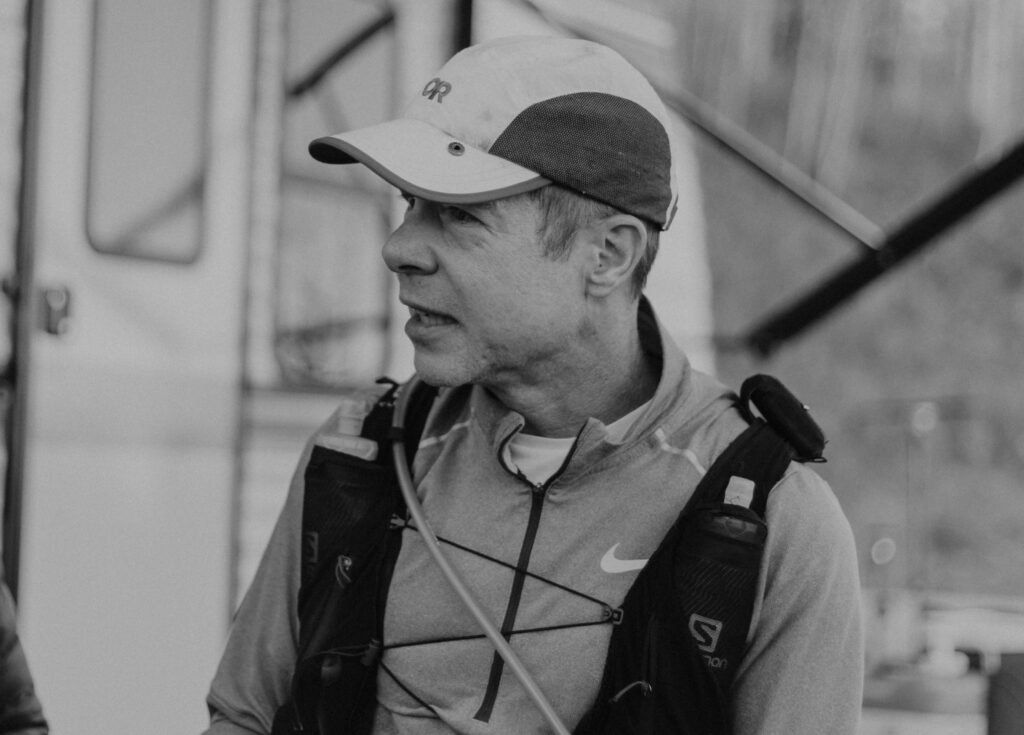
Porcupine Rim to the Finish in Moab (miles 221 to 240)
Porcupine Rim was one of the aid stations where crew was not allowed, but the volunteers did an amazing job of taking care of me. They helped fill my pack with fluids, gave me the small amount of food I wanted to nibble on, and even provided a back rub to try and loosen up my muscles a little. Although there were numerous volunteers throughout the race that gave me tremendous assistance at the uncrewed aid stations, Sara and Lori at Porcupine Rim stood out among that exceptional group.
I departed Porcupine Rim at 5:30 PM in 10th place, but quickly fell back to 11th when Jeff Price passed me two miles into the section just as we turned onto the Porcupine Rim Trail. Jeff had started Moab in 2nd place in the Triple Crown. With only 13 miles of trail and 3 miles of paved bike path between me and the finish, I knew that, even moving at my lethargic pace, there was no way Jeff could regain the 9 ½ hours between his time and mine.
However, there was another Triple Crown runner I was still worried about. Jameson Collins, who was 3rd place in the Triple Crown when he started Moab, and had already finished the race before I left Porcupine Rim aid station. What I didn’t know was the actual time of his finish. He needed to beat me by more than sixteen hours in order to take the top spot in the Triple Crown. Was it possible for him to do that if I moved too slowly?
Porcupine Rim Trail is a mixture of rocky, sandy and smooth sections that make for a fun run when you’re feeling good, but can make for painfully slow running and hiking when you’re not feeling so good. Mentally and physically, this was the most difficult portion of the race for me. The aid station back rub had loosened my back a little, but within the first mile or two my back had already returned to its original state. I moved like an old man with osteoporosis.
Pressing me from behind was Sally McRae, another Triple Crowner. I was unsure how far back she was, but I assumed she was having some struggles of her own or she likely would have already passed me. She was a strong professional runner who was the leading female in the Triple Crown, and I was not going to take it for granted that I could stay ahead of her. She came into Moab thirty hours behind me in the Triple Crown, so there was no chance she was going to overtake me in the 3-race series, but I had already decided that Jeff Price would be the last person to pass me in this race. I would fight tooth and nail to hold my position.
To help motivate me to continue my desperate alternation of walking and running, I used the threat of Sally, along with the threat that Jameson’s unknown finishing time might end up being more than sixteen hours ahead of mine. It helped me focus on driving myself forward. Regardless, every one of those decisions to start running again and to sustain the running as long as possible was a battle of will against what my body wanted to do. My body wanted to walk. Even more, my body wanted to sit down or lay down and rest for as many hours as I would let it.
But I would not do that. Instead, I pressed forward.
After several miles on the Porcupine Rim trail, I could see the headlamps of Sally and her pacer behind me. It’s always hard to guess the distance of another headlamp in the darkness, but I knew she wasn’t very far back. With her strength as a runner, I had no doubt that if she was feeling good, she would make quick work of me.
Eventually, I passed through the culvert at the bottom of Porcupine Rim Trail and stepped onto the bike path. It was 12:45 AM. Only three miles remained. I enjoyed the challenge of the journey that was inherent with every 200-miler I had run, and I also enjoyed the race aspect of it. Although there was no real difference between finishing in 11th place or finishing 12th, I was here to give it my best, not to allow myself to sit back and coast to the finish. I would do everything in my power to prevent Sally, or anyone else, from passing me in these last miles.
I pushed myself even harder. It took every bit of my remaining mental resolve. I wanted this all to end. I wanted to step across the finish line and be done. I wanted to be able to stop moving.
A few times on the bike path I turned my head to see if Sally’s headlamp was visible behind me. Each time, I was careful to keep my flashlight oriented forward and to switch off my headlamp before I turned my head. If Sally saw my headlamp turn towards her, she might know I was afraid she was going to pass me. And if she knew I had reason to be afraid, it might give her the motivation to speed up. But I never saw her headlamp. She was close, but not too close. I kept pushing.
Sally would end up finishing only eleven minutes behind me.
Heather had positioned herself just forward of the finish line. She was such a welcome sight. She ran and walked with me to the finish. I ran across the finish line in my comically bent posture. I stood there for a few moments while volunteers brought me a chair, my poles supporting the weight of my upper body. It felt so good to not have to run or walk or hobble.
By the time I sat down in the chair, I had already concluded that mentally, this had been one of the toughest 200-mile races I’d run. It ranked up there with Bigfoot 200 in 2018 and one or two others. It was one of the few races where I had truly given absolutely everything I had and left every bit of it out on the course. And that is something that will always matter to me more than a finishing place or time.
I finished Moab 240 in 86 hours and 7 minutes. This is the slowest I have ever run any of the fifteen 200+ mile races that I have finished. My best finishing time at Moab was almost 24 hours faster than my 2023 time. I finished in 11th place out of the 202 runners who started the race. I was able to hold onto 1st place in the Triple Crown with a time of 217 hours and 1 minute, and with a gap of 7 ½ hours between me and the 2nd place Triple Crown runner, Jameson Collins.
I would like to thank the volunteers and staff who helped me along the way, of whom there were many. And above all, I would like to thank Heather for her tremendous and loving support at Moab. She has been there for me at ten of the seventeen 200-milers I have attempted, and I would not have done as well in these races without her support.
See you on the trails!
Wes Ritner
